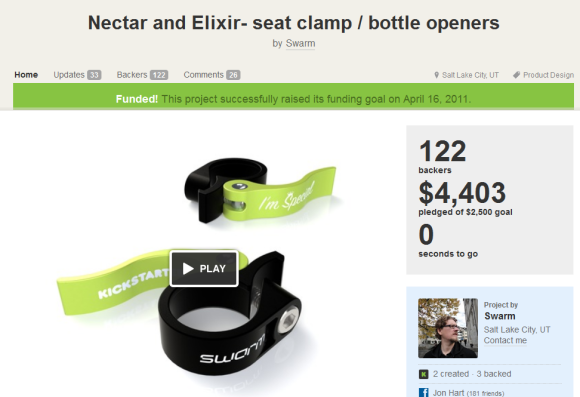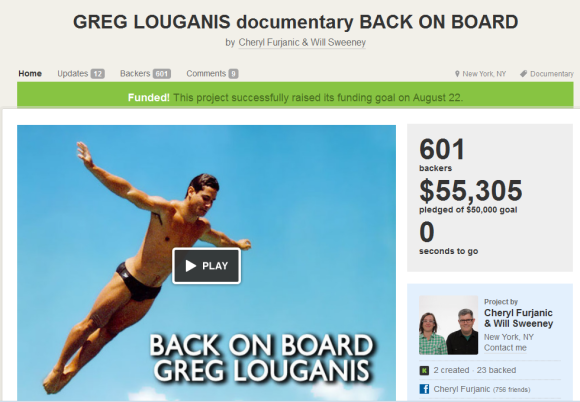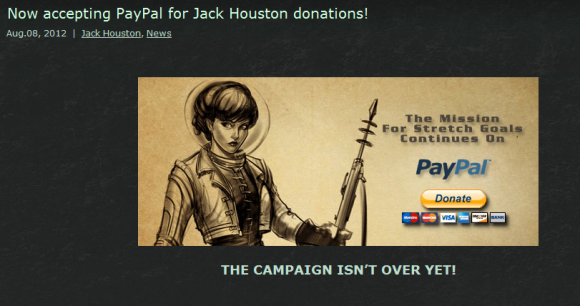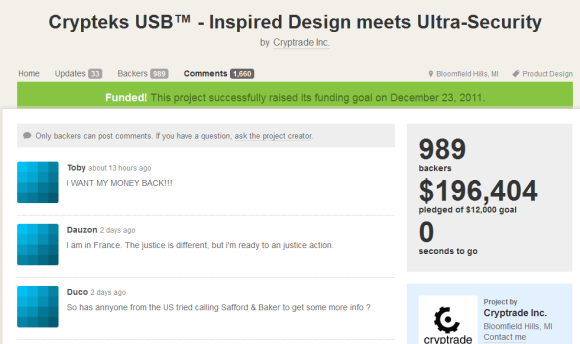What Happens If You Don't Raise Enough Money On Kickstarter
For tens of thousands of entrepreneurs frustrated by Washington's arcane legal rules for raising business capital, Kickstarter has been nothing brusk of a blood-red-tape weed whacker. The crowd-funding website lets individual investors pledge money directly to inventors and artists, handily upending the complex and oftentimes impossible process of raising financing one person at a time.
If you succeed, that is.
Since its launch in 2009, Kickstarter has hosted more than 76,000 projects. Almost 32,000 of them, or 44 percent, have been successfully funded, with a total of $345 one thousand thousand raised.
The road to success on Kickstarter is far from assured, and Kickstarter's own statistics prove that Kickstarter projects accept about a 56 percent failure charge per unit. And that'south only counting projects that Kickstarter accepts. Endless additional projects have never fifty-fifty made it off the launching pad.
How exercise y'all avoid having your project get a statistic while others succeed? Here are some of the most common pitfalls other Kickstarter users take encountered, and ways you can overcome them.
All of the information beneath comes courtesy of entrepreneurs who've experienced failure, success, or both, at the hands of the Kickstarter organisation. Kickstarter declined to participate in this story.

ane. Problem: Kickstarter rejects your project
It'southward impossible to tell how many Kickstarter projects never even go a chance, because there aren't whatsoever statistics on how many are rejected outright by the company.
It is in Kickstarter'south involvement to accept onlyprojects that are reasonably likely to succeed, because Kickstarter gets paid (5 percent of your total funding) justif you achieve your stated funding goal. Miss the goal, and Kickstarter collects nothing—but it still has to do all the legwork of running your funding campaign and hosting your project.
The reasons for rejecting a proposal are numerous and often cryptic. Kickstarter'southward guidelines establish rules for what qualifies for Kickstarter funding, but these aren't always articulate and tin can even exist contradictory. The fundamental rule—that funding is for "projects only"—is at odds with entrepreneurs who want to use funds to build a concrete production that they hope to sell on an ongoing basis, or to use equally the basis for the beginnings of a startup. No one is getting into the Kickstarter game to create a express run of iPad keyboards that, in one case produced, volition never be sold again.
Kickstarter seems to understand this, and it judges projects individually, and so if the language in your description is rejected for not describing a "project," endeavour revising information technology and resubmitting. (Kickstarter does accept an appeals process, but, as Brett Callow of ioSafe told us, "Their web form limits [appeals] submissions to 500 characters, making it impossible to make a detailed case." To raise financing for its latest NAS device, IoSafe somewhen turned to Kickstarter competitor IndieGoGo—a mutual solution to Kickstarter rejection.
Other users study that they didn't receive a reason for their project'southward rejection by Kickstarter. Jennifer Chu'south Silver Linings shoe liners idea was rejected by Kickstarter, she says, without caption. Says Chu, "From what I have heard, Kickstarter gives reasons for declines if they are things yous tin can change. For other issues, they just requite the canned response." Rather than effort to figure out what happened, Chu also jumped to IndieGoGo.

2. Problem: Your project didn't reach its goal
Once Kickstarter has accepted your project, you're hardly out of the forest. A vast number of projects never get off the footing considering they don't meet their funding goal. Remember: If your entrada falls curt of goal, you lot receive none of the funds you've raised.
This is a universal problem with no like shooting fish in a barrel diagnosis. Your rewards may be out of line with expectations—a free baseball hat or DVD in exchange for a $50 donation may non engender much success —or your promotion of your ain project may take fallen short. (Kickstarter prohibits spam merely encourages "smart outreach.")
Successful campaigns have lots of supporting information—including things like photos of prototypes and regular updates—proving that the project'southward founders aren't going to scrap out or run off with the greenbacks—whether due to incompetence or outright scam. Having a video can boost your credibility and funding immeasurably. On IndieGoGo, campaigns with a pitch video raise 114 percentage more cash than those without i.
If you try your hardest and still don't hit your goal, and so what can you do? Try once more, preferably with a smaller goal. In its initial class, Nectar and Elixir's quirky bicycle seat clamp-meets-bottle opener raisedonly $1291 of its original $15,000 goal, an ambitious sum for a simple production. The designers tried again a few weeks subsequently with a $two,500 goal…and successfully raised $4403. Check out The Kickstarter Handbook for an interview with that team for more details.

3. Problem: The cash didn't come through
This is a hopefully rare only troubling problem. Stacy Davidson was seeking $56,000 for a video game project, and he hitting his goal. Simply when Kickstarter ran the investors' credit cards, a few of the pledges turned out to be bogus, including one whopping $ten,000 one. Kickstarter funds projects based on pledges, not actual greenbacks collected, so that left Davidson with a meaning shortfall to cover. Just since completed Kickstarter campaigns can't be reopened or added to, Davidson ended up asking for private donations to help fill in the gap.
Lesson learned: Don't residue on your laurels only because you lot've hit your goal. Keep promoting your project until the time is upwardly, no matter how far over goal y'all are.
4. Problem: You need more than money
This problem is similar to the previous i: What if you met your goal and collected your money, but yous burn down through it too quickly or otherwise find out you need more funds to complete your project?
The near mutual solution here is the aforementioned as in Problem 3. Because you can't ask for more money from Kickstarter, you may turn to individual funding sources to add to the coffers. Cheryl Furjanic and Will Sweeney did just that after raising $50,000 for a Greg Louganis documentary from Kickstarter. The initial investment was enough to get the picture show off the footing, but not plenty to terminate. The duo is using its Kickstarter page to signal backers to additional fundraising opportunities, encouraging them to host fundraising parties and connect them with donors.

5. Problem: You lot're running late
If your project is behind schedule but information technology's going to be finished eventually, the all-time thing yous can do is to but allow people know. This schedule slippage tin can happen for any number of reasons. If, for example, you're developing a mobile accessory, then the fact that Apple inverse the iPhone's connector will throw y'all off schedule. By and large backers are understanding about delays…as long equally you explain yourself in detail.
If you accept a delay, update your Kickstarter page to explain why and, crucially, how lengthy you lot look the delay to be. You merely cannot provide too much information to backers, who brainstorm to get nervous the day after your Estimated Commitment Engagement has passed. That date, by the way, is now required on all projects. Updates on a near-daily basis aren't a bad thought if you want to keep your inbox from overflowing with hate mail and legal threats.

6. Problem: Your project didn't piece of work out
Yous don't need to search for long to find tales of Kickstarter backers upset that they fabricated funding donations and never received their rewards, or fifty-fifty any information about what went wrong.
This isn't entirely unexpected. Kickstarter may require an Estimated Delivery Appointment on all projects, but these are yet estimates, and there'south no enforcement of or consequences for missing that date. (Kickstarter says it is the "creator's responsibility to consummate their projection," but also, "Kickstarter does not guarantee projects or investigate a creator'southward ability to complete their project.") As a outcome, backers are condign increasingly nervous about funding projects if they aren't dead-certain the projects are going to pan out eventually.
As an entrepreneur, information technology's your job to overcome these concerns, but what if, despite your all-time intentions, the proposal just isn't going to make it? What if the technology's non mature enough to exercise what you expected? Do you have a duty to release a Kickstarter-backed motion picture if information technology stinks? Technically, yes: Kickstarter'south Terms of Employ require you lot to release your product or refund backers' money.
If your project is one of the (many) that don't pan out, the best advice is to pull the plug as presently as you tin can. Refund whatever portion of the backers' money you haven't spent, perhaps with a make-good amends advantage for their trouble. (Imagine a bumper sticker: "I invested in Bob's Widgets and all I got was this lousy sticker.") The last affair you want is to exist sued by hundreds of people for $l each. In reality, reports of refunds are rare. If you actually offer 1, you lot'll exist in a very tiny minority.
If y'all finished building it, but your projection isn't viable or the product doesn't work, should you ship information technology? Enquire your backers if they still want your expensive paperweight. As with near things, clear and copious communication with your backers goes an awfully long way to smoothing over bad feelings. Most Kickstarter backers know that nothing is guaranteed, but they admittedly despise radio silence.
Kevin Murray, a frequent Kickstarter backer, puts information technology this way: "For me, the lack of truthfulness and transparency is what leaves a bad gustation. Share the struggle, ask for advice, and an investor may be agreement. Go nighttime, and people volition believe the worst."
Editor's note: This story has been updated to include Kickstarter's statistics about the number of projects that fail.
Note: When you lot purchase something subsequently clicking links in our articles, we may earn a small commission. Read our chapter link policy for more details.
Source: https://www.pcworld.com/article/455531/6-kickstarter-nightmares-and-how-to-prevent-them.html
Posted by: hornerthome1952.blogspot.com


0 Response to "What Happens If You Don't Raise Enough Money On Kickstarter"
Post a Comment